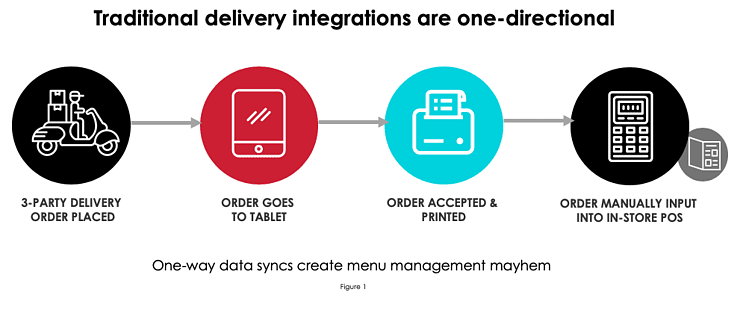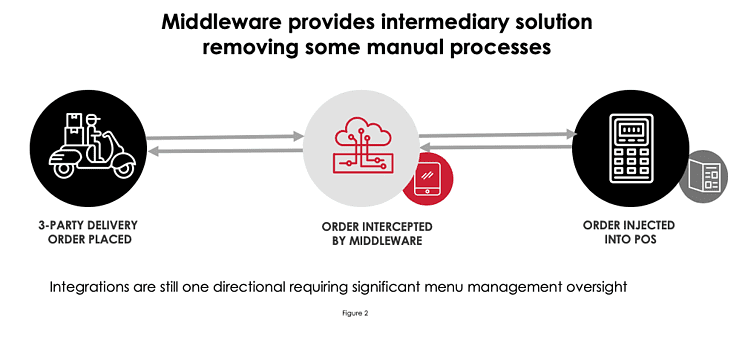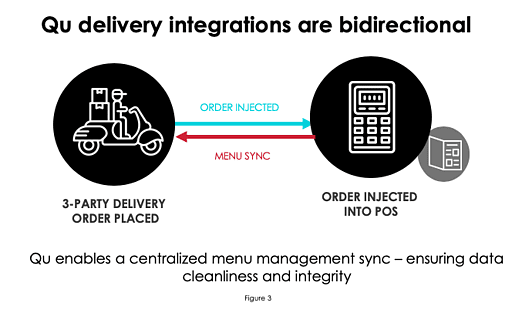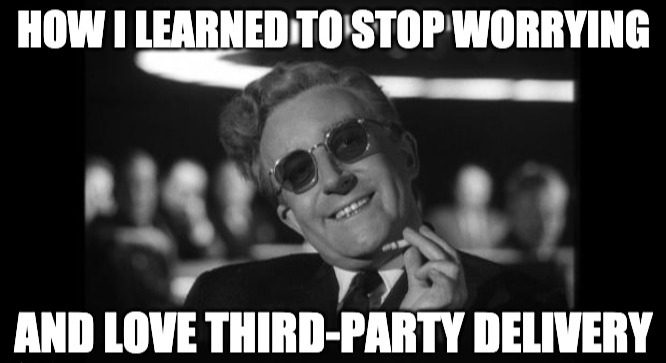We have our own comedic drama playing out in the restaurant world. And it’s been going on for far too long. It’s that story about how third-party delivery upended restaurants and disrupted “business as usual.” I mean seriously folks, it’s getting old, like Dr. Strangelove himself!
Operators, I understand your frustration with third-party delivery and your pain is real. But let’s take a page out of Dr. Strangelove’s book—stop hating and start loving third-party delivery.
How to Stop Hating and Start Loving Third-Party Delivery
I get how disruptive the third-party delivery business has been for all restaurant operators—after all they flat out injected themselves right into the center of your business and some of them have indeed overstepped their bounds…(don’t we all?!)
But the fact is that delivery is here to stay (and grow) and we all need to stop blaming them for causing problems and start working on a collaborative solution that’s going to meet everyone’s needs.
The solution is rooted in consistent cross-channel guest experiences and stronger revenue opportunities, driven by a unifying technology that won’t drain operator budgets and time.
But before we jump into the potential happy endings to our drama, let’s take a quick look at how this has played out over the past 5 years. The evolution and ruckus created by third-party delivery in three very short, albeit dramatic Acts. So grab your popcorn and take a seat folks, this drama is show-stopping!
Act I: Hello Delivery, Goodbye Sanity (for Operators)
In the first act, our protagonist “third-party delivery” burst onto the scene—somewhat unexpectedly like AirBnB and Uber—and was eagerly embraced and welcomed by all as a “Hero.” Our delivery hero was able to satisfy a previously unmet desire for convenience and speed by quenching consumers’ food cravings from wherever they were (uh, everywhere). Restaurant operators similarly welcomed our Delivery Hero as it provided incremental revenue, access to guests previously unknown, and enhanced brand exposure.
Act I quickly turned into an epic star-studded drama when the Hero unwittingly was lured to the dark side (now we all feel a bit like Obi Wan).

The Downfall of our Hero and the Rise of the Dark Side
- Menu Management Mayhem. Third-party delivery providers introduced their own individual menu system into the mix of already burgeoning order channels for operators. More menu systems meant more chaos and a disjointed ordering experience. As a result, the guest experience became harder to control—managing menu and food integrity, quality, and consistency across delivery channels was very challenging for operators. And when menu blunders resulted, guests didn’t blame our Hero, but instead blamed the restaurant brands.
- Tablet Hell. Each delivery company placed a physical tablet in the restaurant to process orders. This created crowded countertops (“tablet hell”) and more in-store labor to manage the manual process of printing delivery orders and inputting them directly into the in-store POS. Restaurant operators had more digital orders coming in, but costs and complexity also increased with the added labor and manual processes.
- Manual and Inaccurate Order Entry (+Annoyed Guests). The process of printing and re-keying the delivery orders from tablets to the in-store POS make order errors more likely through things like “fat-fingering” or human error. We all know that inaccurate order entry results in loss of transaction level data, making accurate reporting even more challenging than it already is.

To avert these Act I crises, some resource-rich restaurant brands opted to create their own mobile delivery app or build their own custom integrations with particular delivery providers. Some have spent hundreds of millions on solutions trying to fix these menu management and technology integration issues.
For example, Yum Brands (owner of Taco Bell, KFC, and Pizza Hut) jumped on the delivery growth engine last year and made a huge investment (+$200M) with GrubHub by integrating the delivery service right into their POS. This gave their guests unprecedented access to their food, reduced the redundant order-entry processes in-store, and gave them access to the data.
Yes, Yum Brands has the marketing and financial power to make huge investments, but this type of solution shouldn’t be exclusive to big brands able to make hundred-million-dollar investments into their tech.
Act II: We Need a Savior. Enter Middleware.
Okay, Act I was a bit of a rollercoaster and clearly things seemed to be heading south for restaurant operators. Third-party delivery was eating into operator’s profits (and interrupting the guest experience), and operators were forced to invest in fixing the menu mayhem.
The scene was ripe for a savior. [Enter, stage right] The Middleware and API-only companies.
To eliminate manual processes, reduce the potential for errors, and streamline the ordering and menu data between systems— middleware and API-only companies came onto the scene. They promised to take all the delivery orders coming in from all channels and funnel them directly into the restaurant POS through a rigorous back-end process that consisted of intercepting and scraping the order and mapping it directly to the POS’s master menu.
And their solution worked well…in certain situations. The truth is, for middleware to work well, you need to create an almost perfect environment for data creation, storage, movement and analysis (and we all know, no one’s perfect). Have you ever seen an item get created in a POS? 😂
Some limitations of middleware:
- You Need an Exact Match between Restaurant POS Menu and Delivery Menu items. For the delivery order to be accepted by the restaurant POS with middleware, there must be an exact match between the item-level data in both menus. If there is anything off (i.e., name or price), the order will be rejected by the POS.
- Some Changes can ONLY be Done at the Tablet Level. There are certain menu changes hat cannot be done with the middleware solution; they can only be done directly on the tablets. Thus requiring human intervention and more labor/resources that get distracted from serving your guests. It doesn’t really remove the tablets.
- Limited Menu Depth. Most third-party delivery menus have limited item menu depth. You can add or subtract items and modifiers. This is beginning to change, but until it’s more mainstream, fluidly syncing 2-item menu depth with much deeper restaurant POS is not a seamless or frictionless process.
Our Act II saviors were well intentioned, but middleware created a new set of problems for operators. It required them to invest in more tech platforms (more cost), create new integrations (more risk), and compromised data integrity (reporting inaccuracy)—all bottle-necking revenue generation.
As shown in Figure 2, the middleware APIs are often one-directional, requiring significant oversight to ensure the order management process (menu items) and operational data sync properly between the tablets, delivery sites, and restaurant systems.

Act III. Drama Be Gone. The Direct Third-Party Delivery Solution.
Yes, happy endings are possible! Our third act opens with a key realization. The Hero in our story all along was never third-party deliveries, middleware, or even POS companies like us. The Hero in this story is your restaurant brand.
And the solution to your problem? A unified food experience enabled by a POS platform that is intentionally built with bi-directional integrations with your third-party delivery apps. No need for a middleware manager.
Although there are plenty of options for POS out there for you, there are few companies solving for the core issues faced specifically by enterprise fast-casual and QSR operators. Qu’s unified food experience ensures one set of clean, normalized data flows fluidly between the two systems and finally solves for the core issues we discussed earlier.
How does Qu make this possible?
- Unified Menu Management. Operators finally have access to a single unified menu that can exist across all of their channels: in-store, delivery, and other digital sites. You can make menu updates universally across all desired channels and customize configuration settings to determine where and when items are displayed. Qu’s infinite depth of modifications allows for easy configurations across all channels. Your POS won’t hold you back.
- Tablet-Heaven. Qu’s open and modern API-first infrastructure means you can say goodbye to brittle integrations. You no longer need multiple tablets on the counter for all your third-party delivery apps. Qu’s APIs were written to work for all partners’ needs, not one specific vendor or data call. The APIs leverage bi-directional data syncs that flow from one database and core processing engine in the cloud, enabling fluid data exchanges that keep your data clean. The data is normalized between delivery and the POS system. No more worrying about menu mapping and order rejection.
- A Centralized Management Hub Removes Unnecessary Redundancies. Through Qu’s Enterprise Management Hub, we enable highly dynamic menu items that are changeable based on context. You can configure an item to have unlimited characteristics, which can be customized at any time, for any channel. For example, you can create unique pricing and availability, across multiple channels, without having to create multiple items.
Having dynamic items means you have access to unified data and insights, and can retain the integrity of a master menu for reporting purposes. So say goodbye to manual and painstaking processes to update your menus. Now you can manage your business from one centralized hub.

The Benefits:
-
- Labor Efficiency – Removes the need for labor to manage tablets and in-store employees focus 100% on serving live customers.
- Order & Report Accuracy – direct and automated menu mapping between delivery and POS systems increases order accuracy and reporting.
- Cost Control – avoid lost orders and lost revenue.
- Revenue Acceleration – with consistent and normalized data flowing between systems you can finally see and uncover opportunities for revenue growth.
- Less Risk – Fewer integrations means less risk for your business processes.
[Curtain Closes – Audience Cheers]


